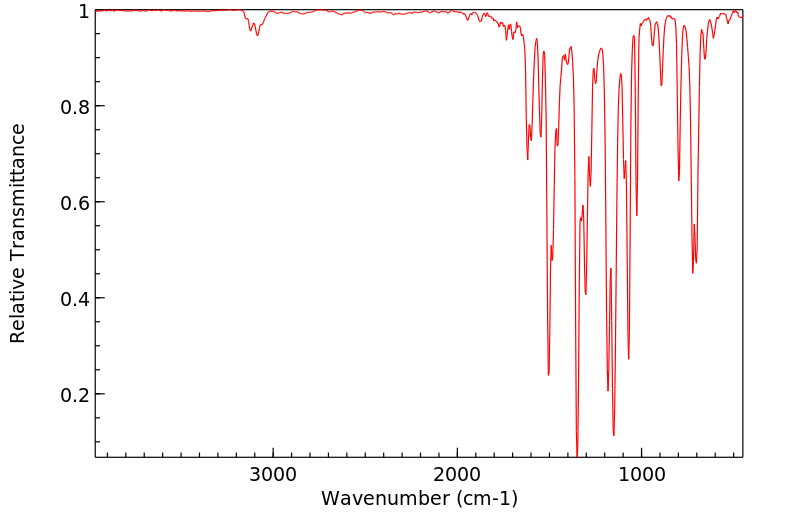1-[3-(三氟甲基)苯基]吡咯 | 53871-26-4
中文名称
1-[3-(三氟甲基)苯基]吡咯
中文别名
1-[3-(三氟甲基)苯]吡咯
英文名称
1-<(3-trifluoromethyl)phenyl>pyrrole
英文别名
1-(3-(trifluoromethyl)phenyl)-1H-pyrrole;1-(3-trifluoromethylphenyl)-1H-pyrrole;1-(3-trifluoromethyl-phenyl)-pyrrole;1-[3-(trifluoromethyl)phenyl]-1H-pyrrole;1-[3-(trifluoromethyl)phenyl]pyrrole
CAS
53871-26-4
化学式
C11H8F3N
mdl
MFCD00118895
分子量
211.186
InChiKey
WEOYJGQSAGJWQH-UHFFFAOYSA-N
BEILSTEIN
——
EINECS
——
-
物化性质
-
计算性质
-
ADMET
-
安全信息
-
SDS
-
制备方法与用途
-
上下游信息
-
文献信息
-
表征谱图
-
同类化合物
-
相关功能分类
-
相关结构分类
物化性质
-
熔点:48-50℃
-
沸点:74-76/1.5mm
计算性质
-
辛醇/水分配系数(LogP):3.2
-
重原子数:15
-
可旋转键数:1
-
环数:2.0
-
sp3杂化的碳原子比例:0.09
-
拓扑面积:4.9
-
氢给体数:0
-
氢受体数:3
SDS
反应信息
-
作为反应物:描述:1-[3-(三氟甲基)苯基]吡咯 、 二氧化碳 在 正丁基锂 、 四甲基乙二胺 作用下, 以 乙醚 为溶剂, 反应 1.0h, 以57%的产率得到1-<2-carboxy-5-(trifluoromethyl)phenyl>pyrrole-2-carboxylic acid参考文献:名称:三氟甲基对分子结构的影响:1-[((三氟甲基)苯基]吡咯的竞争性单和双锂化摘要:根据1-[((三氟甲基)苯基]吡咯的锂化和随后的羧化过程中所用的条件,选择性地制备了单-和二羧化的衍生物。根据从文献中收集的数据,可以合理化单羧酸的区域选择性形成。借助于分子建模和单晶X射线测量,已阐明了其他现象的解释,例如区域选择性二氢脱硅和三氟甲基对邻位吡咯环的结构和芳香性的强大影响。DOI:10.1016/s0040-4020(99)00398-1
-
作为产物:描述:顺式-1,2-二羟甲基乙烯 、 间氨基三氟甲苯 在 2,2'-联吡啶 、 sodium carbonate 、 nickel dichloride 作用下, 以 甲苯 为溶剂, 反应 36.0h, 以30%的产率得到1-[3-(三氟甲基)苯基]吡咯参考文献:名称:使用芳醇和烷基胺的二醇进行镍催化的N取代吡咯的合成摘要:在本文中,报道了使用具有一系列芳基,烷基和杂芳基胺的丁烯-1,4-二醇和丁炔1,4-二醇,镍催化的可持续合成N-取代的吡咯的策略。催化方案可耐受游离醇,卤化物,烷基,烷氧基,氧杂环,活化的苄基和吡啶部分,并能产生高达90%的收率。最初的机理研究涉及确定的镍催化剂,速率的确定和反应顺序,包括氘标记实验,用于吡咯合成。DOI:10.1021/acs.joc.8b02666
文献信息
-
l-(+)-Tartaric acid and choline chloride based deep eutectic solvent: An efficient and reusable medium for synthesis of N-substituted pyrroles via Clauson-Kaas reaction作者:Ping Wang、Fei-Ping Ma、Zhan-Hui ZhangDOI:10.1016/j.molliq.2014.07.015日期:2014.10l-(+)-Tartaric acid–choline chloride based deep eutectic solvent has been found to be an effective promoted medium for Clauson-Kaas reaction of aromatic amines and 2,5-dimethoxytetrahydrofuran. Structurally diverse N-substituted pyrroles were obtained in high to excellent yields under mild conditions. The deep eutectic solvent is inexpensive, non-toxic, reusable and biodegradable.已经发现,基于1 -(+)-酒石酸-氯化胆碱的低共熔溶剂是促进芳香胺和2,5-二甲氧基四氢呋喃的Clauson-Kaas反应的有效促进介质。在温和条件下以高产率至优异产率获得结构多样的N-取代的吡咯。该深共晶溶剂便宜,无毒,可重复使用且可生物降解。
-
Unique chemoselective Clauson–Kass reaction of substituted aniline catalyzed by MgI2 etherate作者:Xingxian Zhang、Junchen ShiDOI:10.1016/j.tet.2010.12.018日期:2011.2Clauson–Kass reaction of various substituted aniline, primary aryl amide, and sufonyl amide with 2,5-dimethoxytetrahydrofuran was realized in the presence of 10 mol % of MgI2 etherate in a mild, efficient, and highly chemoselective manner. Iodide counterion and solvents (i.e., MeCN) played the critical roles for the unique reactivity of this catalytic system.
-
AN EFFICIENT AND RAPID SYNTHESIS OF N-SUBSTITUTED PYRROLES BY MICROWAVE ASSISTED SOLID ACID CATALYSIS作者:Mohammed Abid、Shainaz M. Landge、Béla TörökDOI:10.1080/00304940609356444日期:2006.10total synthesis of these compounds .' Accordingly, extended efforts have been made toward the synthesis of wide range of pyrrole derivatives. Most of these methods involve various cyclocondensations reactions resulting in 254or polysubstituted pyrroles.2 However, the environmentally benign synthesis of N-monosubstituted pyrroles is still a challenge. The commonly used traditional P205 catalysis has disadvantagesF'yrroles 代表一类重要的杂环化合物,在许多具有生物活性的天然产物中作为结构基序出现,并在这些化合物的全合成中充当构件。因此,已经为合成广泛的吡咯衍生物做出了更大的努力。这些方法中的大多数涉及各种环缩合反应,产生 254 或多取代吡咯。2 然而,N-单取代吡咯的环境友好合成仍然是一个挑战。常用的传统P205催化反应时间长、收率低、处理困难等缺点?我们的目标是开发一种新的现代方法,既能提供高产量,又能满足最近的环境标准和安全问题。在过去的几十年中,大量出版物表明,固体酸催化 4 和微波辐射已成为有机合成中的重要工具。K-10 蒙脱石是有机合成中最著名和应用最广泛的固体酸之一。由于其强酸性、显着的表面积和高稳定性,它是酸和双功能催化的首选催化剂:继续我们在固体酸催化合成有机化合物方面的努力,henein 我们报告了一种新型的、单锅、通用和使用蒙脱石 K10 和微波辐射快速合成 N 取代的吡咯。对于初步研究,我们选择了苯胺与
-
Reductive One Batch Synthesis of N-Substituted Pyrrolidines from Primary Amines and 2,5-Dimethoxytetrahydrofuran作者:Giancarlo Verardo、Anna Dolce、Nicoletta ToniuttiDOI:10.1055/s-1999-3685日期:——The construction of the pyrrolidine ring about a nitrogen of a primary amine by a reductive condensation reaction using 2,5-dimethoxytetrahydrofuran and sodium borohydride in acidic water medium is described. The reaction is fast, affords good to excellent yields and appears insensitive to electron effects and severe steric hindrance; it is found to be compatible with a large variety of aryl substituents, including nitro and oxo groups. The reaction allows the introduction of two deuterium atoms, with label conservation, in both the α-positions of the pyrrolidine ring by the use of sodium borodeuteride instead of sodium borohydride.
-
A recyclable magnetic nanoparticles supported antimony catalyst for the synthesis of N-substituted pyrroles in water作者:Fei-Ping Ma、Pei-He Li、Bao-Le Li、Li-Ping Mo、Ning Liu、Hui-Jun Kang、Ya-Nan Liu、Zhan-Hui ZhangDOI:10.1016/j.apcata.2013.03.005日期:2013.4A new magnetic nanoparticle-supported catalyst for Clauson-Kaas reaction. The corresponding N-substituted pyrroles in by magnetic separation and recycled for antimony catalyst was prepared and evaluated as a recoverable reaction proceeds efficiently in aqueous medium to give the high yield. The immobilized catalyst could be easily recovered six times without significant loss of its catalytic activity. (c) 2013 Elsevier B.V. All rights reserved.
表征谱图
-
氢谱1HNMR
-
质谱MS
-
碳谱13CNMR
-
红外IR
-
拉曼Raman
-
峰位数据
-
峰位匹配
-
表征信息
同类化合物
黄胆红酸
高树蛙毒素
颜料红2254
阿根诺卡菌素
阿托伐他汀镁
阿托伐他汀钙阿托伐他汀钙中间体1甲酯
阿托伐他汀钙杂质59
阿托伐他汀钙杂质52
阿托伐他汀钙杂质43
阿托伐他汀钙杂质
阿托伐他汀钙杂质
阿托伐他汀钙三水合物
阿托伐他汀钙L-8
阿托伐他汀钙
阿托伐他汀酸异丙酯
阿托伐他汀酰基-Β-D-葡糖苷酸
阿托伐他汀缩丙酮
阿托伐他汀相关化合物E
阿托伐他汀甲酯
阿托伐他汀甲胺盐
阿托伐他汀烯丙基酯
阿托伐他汀杂质F
阿托伐他汀杂质95
阿托伐他汀杂质5
阿托伐他汀杂质31
阿托伐他汀杂质1
阿托伐他汀叔丁酯
阿托伐他汀双氟杂质中间体
阿托伐他汀内酯-[D5]
阿托伐他汀内酯
阿托伐他汀乙酯
阿托伐他汀USP相关物质E
阿托伐他汀L1二胺物杂质
阿托伐他汀3-羟基消除杂质
阿托伐他汀3-氧杂质
阿托伐他汀
阿利考昔
阿伐他汀钠
镍(II)(吡唑二氰胺)2
镉原卟啉IX二甲酯
铬,二溴二(吡啶)-
达考帕泛
费耐力
角质形成细胞分化诱导剂
西拉美新盐酸盐
西拉美新
虫螨腈
萨格列扎
苏尼替尼N-1
芬度柳







